Personality Traits and Family SES Moderate the Relationship between Media Multitasking and Reasoning Performance
Abstract
1. Introduction
1.1. Media Multitasking and Cognitive Abilities
1.2. Personality Traits as Potential Moderators for the Relationship
1.3. Family SES as a Potential Moderator for the Relationship
1.4. The Present Study
2. Materials and Methods
2.1. Participants
2.2. Measures
2.2.1. Media Multitasking
2.2.2. Reasoning Performance
2.2.3. Big Five Personality Traits
2.2.4. Impulsiveness
2.2.5. Grit
2.2.6. Family SES
2.3. Procedure
2.4. Statistical Analysis
3. Results
3.1. Descriptive Statistics
3.2. Differences in Reasoning Performance between Heavy and Light Media Multitaskers
3.3. Moderating Roles of Personality Traits and Family SES in the Relationship between MMI and Reasoning Performance
4. Discussion
5. Conclusions
Author Contributions
Funding
Institutional Review Board Statement
Informed Consent Statement
Data Availability Statement
Conflicts of Interest
Appendix A
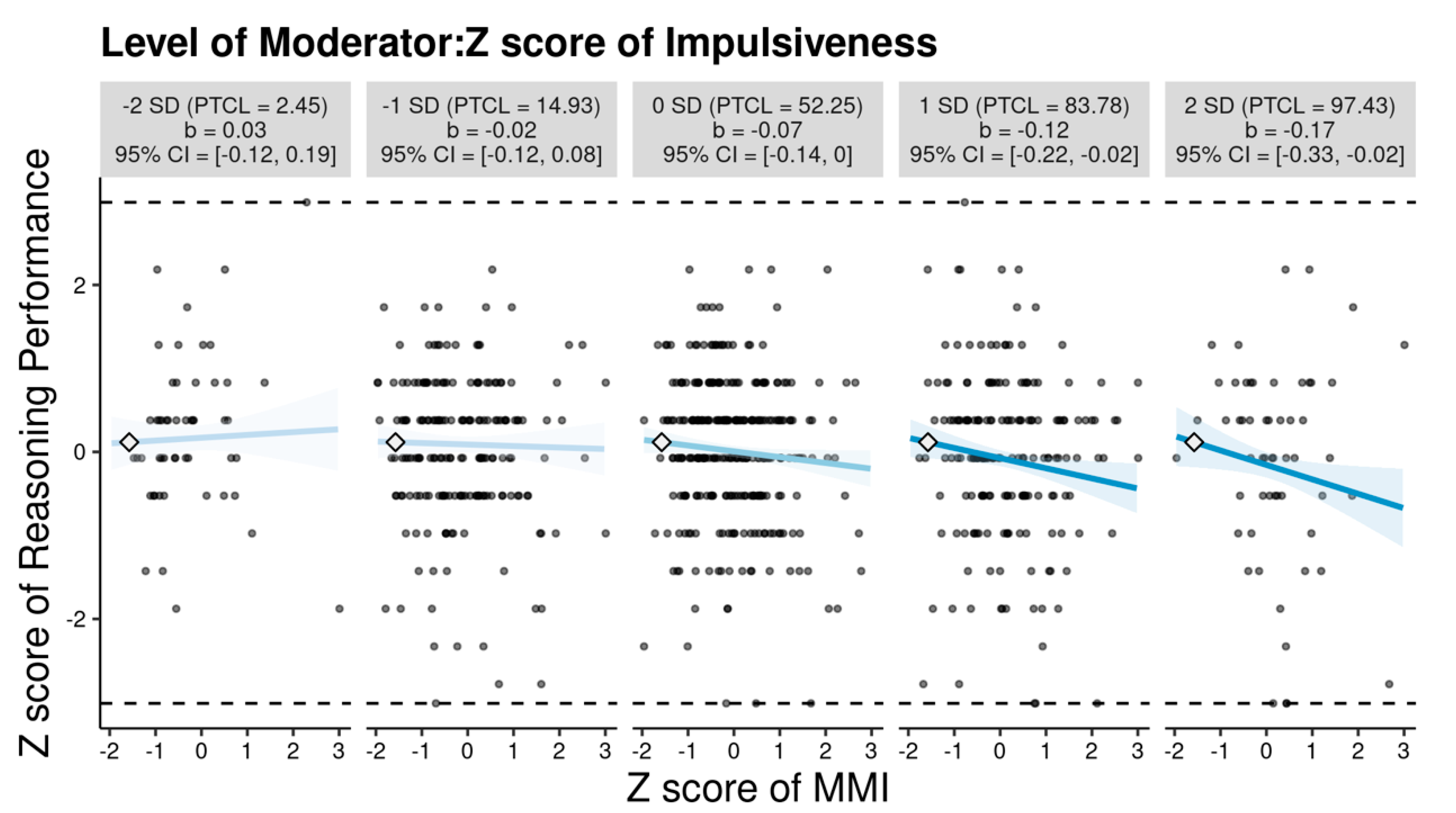
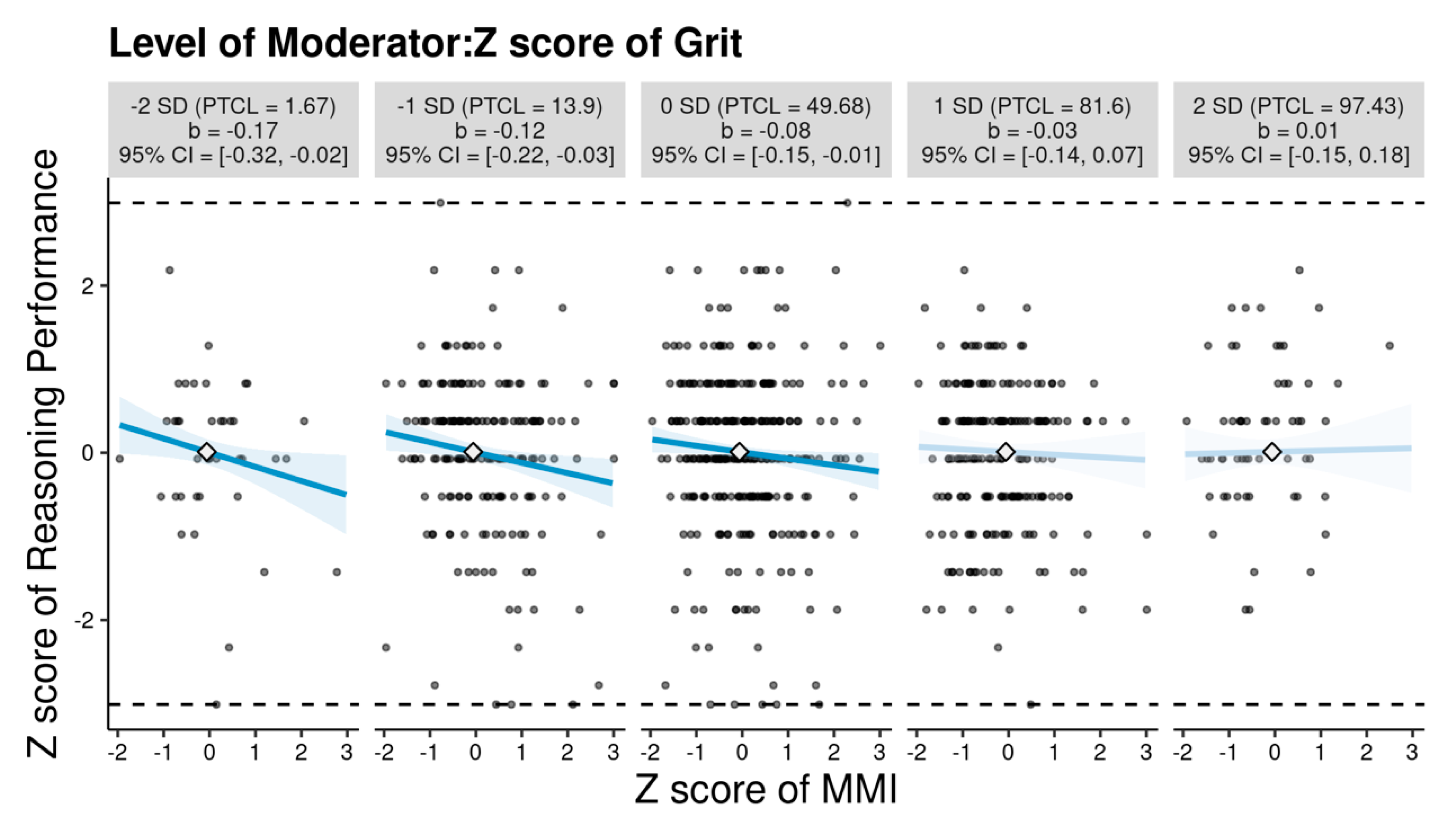
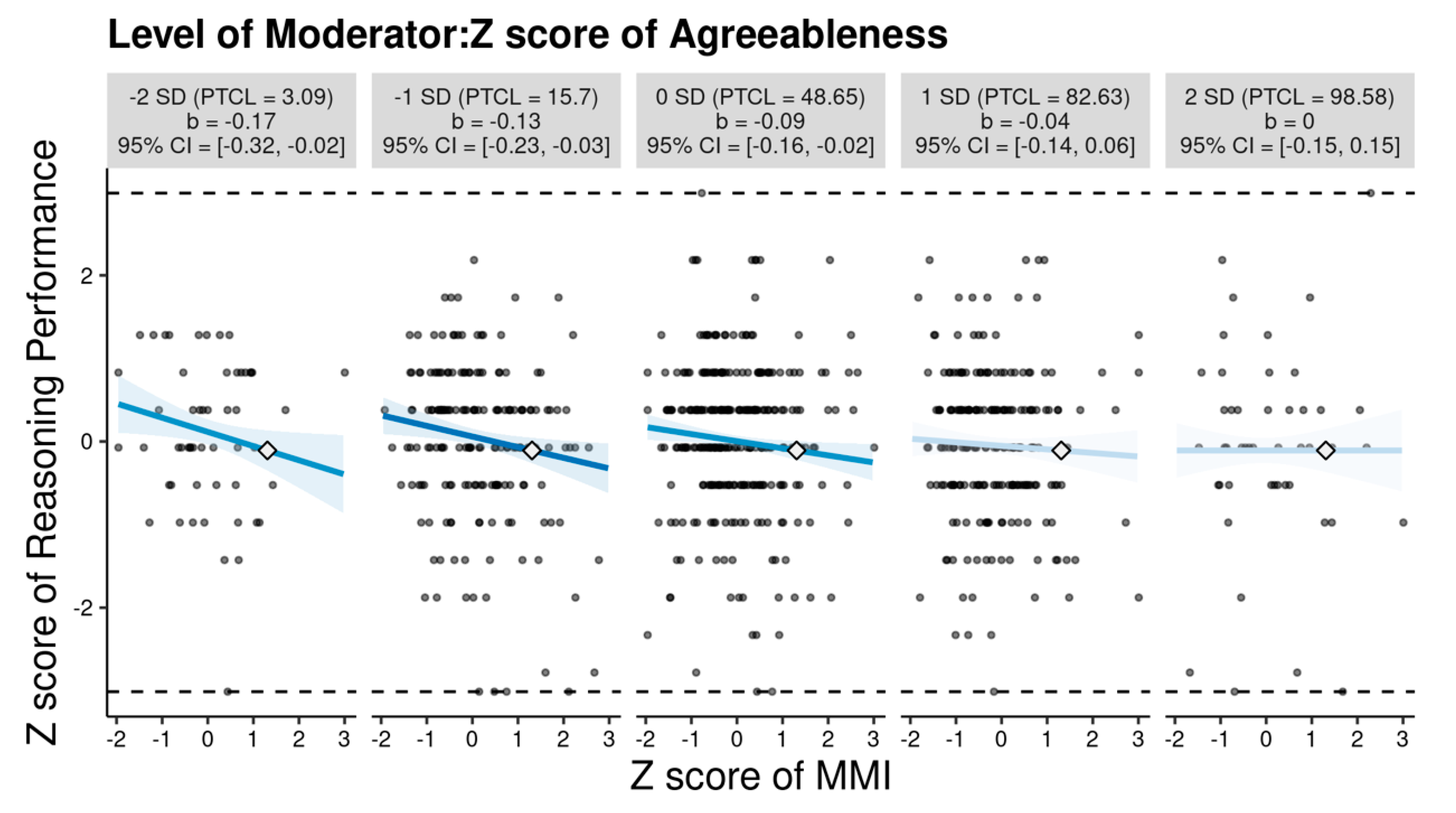
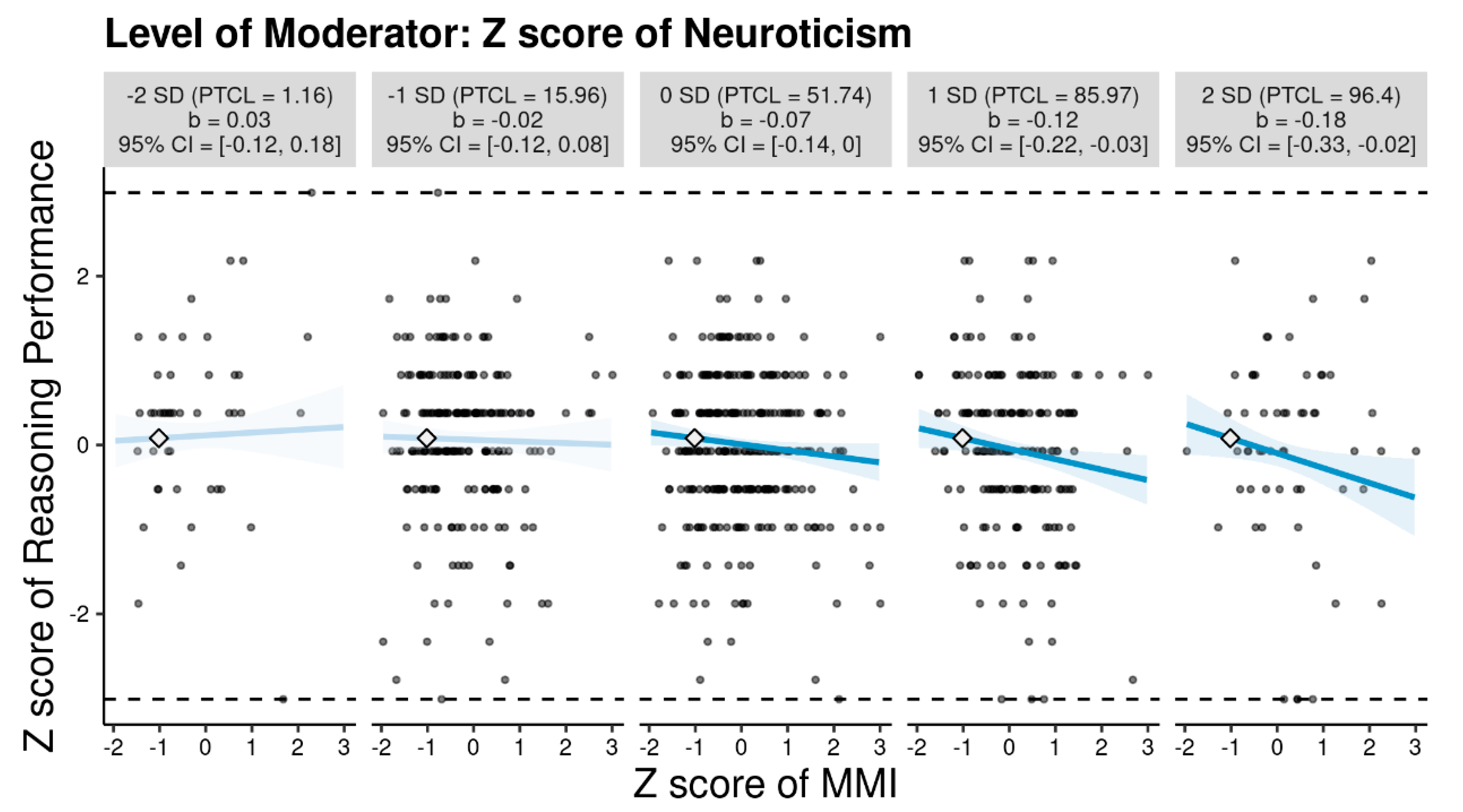
References
- Alzahabi, Reem, Mark W. Becker, and David Z. Hambrick. 2017. Investigating the relationship between media multitasking and processes involved in task-switching. Journal of Experimental Psychology: Human Perception and Performance 43: 1872–94. [Google Scholar] [CrossRef] [PubMed]
- Baumgartner, Susanne E., and Wisnu Wiradhany. 2022. Not all media multitasking is the same: The frequency of media multitasking depends on cognitive and affective characteristics of media combinations. Psychology of Popular Media 11: 1–12. [Google Scholar] [CrossRef]
- Baumgartner, Susanne E., Wouter D. Weeda, Lisa L. van der Heijden, and Mariëtte Huizinga. 2014. The relationship between media multitasking and executive function in early adolescents. The Journal of Early Adolescence 34: 1120–44. [Google Scholar] [CrossRef]
- Bleidorn, Wiebke, Ted Schwaba, Anqing Zheng, Christopher J. Hopwood, Sosa S. Sosa, Brent W. Roberts, and D. A. Briley. 2022. Personality stability and change: A meta-analysis of longitudinal studies. Psychological Bulletin 148: 588–619. [Google Scholar] [CrossRef] [PubMed]
- Brasel, S. Adam, and James Gips. 2017. Media multitasking: How visual cues affect switching behavior. Computers in Human Behavior 77: 258–65. [Google Scholar] [CrossRef]
- Cardoso-Leite, Pedro, C. Shawn Green, and Daphne Bavelier. 2015. On the impact of new technologies on multitasking. Developmental Review 35: 98–112. [Google Scholar] [CrossRef]
- Chen, Leida, Ravi Nath, and Zhenya Tang. 2020. Understanding the determinants of digital distraction: An automatic thinking behavior perspective. Computers in Human Behavior 104: 106195. [Google Scholar] [CrossRef]
- Chen, Xingyu, Yitong Wang, Da Tao, Ling Jiang, and Shaobo Li. 2021. Antecedents of smartphone multitasking: Roles of demographics, personalities and motivations. Internet Research 31: 1405–43. [Google Scholar] [CrossRef]
- Cohen, Jacob. 1988. Statistical Power Analysis for the Behavioral Sciences, 2nd ed. Mahwah: L. Erlbaum Associates. [Google Scholar]
- Costa, Paul T., and Robert R. McCrae. 1992. Revised NEO Personality Inventory (NEO PI-R) and NEO Five-Factor Inventory (NEO-FFI). Professional Manual. Odessa: Psychological Assessment Resources. [Google Scholar]
- Deloitte. 2019. Digital Media Trends Survey, 13th ed. Oakland: Deloitte Development LLC. [Google Scholar]
- Di Plinio, Simone, Simone Arno, Mauro G. Perrucci, and Sjoerd J. H. Ebisch. 2019. Environmental control and psychosis-relevant traits modulate the prospective sense of agency in non-clinical individuals. Consciousness and Cognition 73: 102776. [Google Scholar] [CrossRef]
- Duckworth, Angela L., Christopher Peterson, Michael D. Matthews, and Dennis R. Kelly. 2007. Grit: Perseverance and passion for long-term goals. Journal of Personality and Social Psychology 92: 1087. [Google Scholar] [CrossRef]
- Edwards, Kathleen S., and Myoungju Shin. 2017. Media multitasking and implicit learning. Attention, Perception, and Psychophysics 79: 1535–49. [Google Scholar] [CrossRef] [PubMed]
- Ewen, Robert B. 2009. An Introduction to Theories of Personality, 7th ed. Hillsdale: Lawrence Erlbaum. [Google Scholar]
- Faul, Franz, Edgar Erdfelder, Albert-Georg Lang, and Axel Buchner. 2007. G*Power 3: A flexible statistical power analy-sis program for the social, behavioral, and biomedical sciences. Behavior Research Methods 39: 175–91. [Google Scholar] [CrossRef] [PubMed]
- Fisher, Jacob T., Frederic R. Hopp, Yibei Chen, and Rene Weber. 2023. Uncovering the structure of media multitasking and attention problems using network analytic techniques. Computers in Human Behavior 147: 107829. [Google Scholar] [CrossRef]
- Forster, Sophie, and Nilli Lavie. 2014. Distracted by your mind? Individual differences in distractibility predict mind wandering. Journal of Experimental Psychology: Learning, Memory, and Cognition 40: 251–60. [Google Scholar] [CrossRef]
- Friedman, Naomi P., Akira Miyake, Robin P. Corley, Susan E. Young, John C. DeFries, and John K. Hewitt. 2006. Not all executive functions are related to intelligence. Psychological Science 17: 172–79. [Google Scholar] [CrossRef] [PubMed]
- Furnham, Adrian, and Anna Bradley. 1997. Music while you work: The differential distraction of background music on the cognitive test performance of introverts and extraverts. Applied Cognitive Psychology 11: 445–55. [Google Scholar] [CrossRef]
- Furnham, Adrian, and Kathryn Allass. 1999. The influence of musical distraction of varying complexity on the cognitive performance of extroverts and introverts. European Journal of Personality 13: 27–38. [Google Scholar] [CrossRef]
- Gardner, Donald G. 1986. Activation theory and task design: An empirical test of several new predictions. Journal of Applied Psychology 71: 411. [Google Scholar] [CrossRef] [PubMed]
- Gerbing, David W., Stephen A. Ahadi, and Jim H. Patton. 1987. Toward a conceptualization of impulsivity: Components across the behavioral and self-report domains. Multivariate Behavioral Research 22: 357–79. [Google Scholar] [CrossRef]
- Gignac, Gilles E., and Eva T. Szodorai. 2016. Effect size guidelines for individual differences researchers. Personality and Individual Differences 102: 74–78. [Google Scholar] [CrossRef]
- Goldberg, Lewis R. 1992. The development of markers for the Big-Five factor structure. Psychological Assessment 4: 26–42. [Google Scholar] [CrossRef]
- Himi, Samsad Afrin, Gregor Volberg, Markus Bühner, and Sven Hilbert. 2023. Individual differences in everyday multitasking behavior and its relation to cognition and personality. Psychological Research 87: 655–85. [Google Scholar] [CrossRef] [PubMed]
- Hollingshead, August B. 1975. Four Factor Index of Social Status. New Haven: Yale University. [Google Scholar]
- Horwood, Sharon, and Jeromy Anglim. 2018. Personality and problematic smartphone use: A facet-level analysis using the Five Factor Model and HEXACO frameworks. Computers in Human Behavior 85: 349–59. [Google Scholar] [CrossRef]
- John, Oliver P., and Sanjay Srivastava. 1999. The Big Five trait taxonomy: History, measurement, and theoretical perspectives. In Handbook of Personality: Theory and Research. Berkeley: University of California, vol. 2, pp. 102–38. Available online: https://personality-project.org/revelle/syllabi/classreadings/john.pdf (accessed on 5 March 2024).
- Jung, Bohdan, and Tadeusz Kowalski. 2022. Media management: The attention perspective. Zarządzanie Mediami 10: 1–21. [Google Scholar] [CrossRef]
- Kononova, Anastasia, Pradnya Joshi, and Shelia Cotten. 2019. Contrary to myth, older adults multitask with media and technologies, but studying their multitasking behaviors can be challenging. Innovation in Aging 3: igz029. [Google Scholar] [CrossRef] [PubMed]
- Kraushaar, James M., and David C. Novak. 2010. Examining the affects of student multitasking with laptops during the lecture. Journal of Information Systems Education 21: 241–52. [Google Scholar]
- Kvist, Ann Valentin, and Jan-Eric Gustafsson. 2008. The relation between fluid intelligence and the general factor as a function of cultural background: A test of Cattell’s Investment theory. Intelligence 36: 422–36. [Google Scholar] [CrossRef]
- Li, Chenyu, Xuezhu Ren, Karl Schweizer, and Tengfei Wang. 2022. Strategy use moderates the relation between working memory capacity and fluid intelligence: A combined approach. Intelligence 91: 101627. [Google Scholar] [CrossRef]
- Li, Xianyun, Michael R. Phillips, Dong Xu, Yali Zhang, Shaojie Yang, Yongsheng Tong, Zhiqing Wang, and Yajuan Niu. 2011. Reliability and validity of an adapted Chinese version of Barratt Impulsiveness Scale. Chinese Mental Health Journal 25: 610–15. [Google Scholar]
- Loh, Kep Kee, and Stephen Wee Hun Lim. 2020. Positive associations between media multitasking and creativity. Computers in Human Behavior Reports 1: 100015. [Google Scholar] [CrossRef]
- Luo, Jiutong, Pui-Sze Yeung, and Hui Li. 2022. Impact of media multitasking on executive function in adolescents: Behavioral and self-reported evidence from a one-year longitudinal study. Internet Research 32: 1310–28. [Google Scholar] [CrossRef]
- Madore, Kevin P., Anna M. Khazenzon, Cameron W. Backes, Jiefeng Jiang, Melina R. Uncapher, Anthony M. Norcia, and Anthony D. Wagner. 2020. Memory failure predicted by attention lapsing and media multitasking. Nature 587: 87–91. [Google Scholar] [CrossRef] [PubMed]
- McCabe, Connor J., Dale S. Kim, and Kevin M. King. 2018. Improving Present Practices in the Visual Display of Interactions. Advances in Methods and Practices in Psychological Science 1: 147–65. [Google Scholar] [CrossRef] [PubMed]
- McCrae, Robert R., and Paul T. Costa, Jr. 1997. Conceptions and correlates of openness to experience. In Handbook of Personality Psychology. Cambridge: Academic Press, pp. 825–47. [Google Scholar] [CrossRef]
- Minear, Meredith, Faith Brasher, Mark McCurdy, Jack Lewis, and Andrea Younggren. 2013. Working memory, fluid intelligence, and impulsiveness in heavy media multitaskers. Psychonomic Bulletin and Review 20: 1274–81. [Google Scholar] [CrossRef] [PubMed]
- Miyake, Akira, Naomi P. Friedman, Michael J. Emerson, Alexander H. Witzki, Amy Howerter, and Tor D. Wager. 2000. The unity and diversity of executive functions and their contributions to complex “Frontal Lobe” tasks: A latent variable analysis. Cognitive Psychology 41: 49–100. [Google Scholar] [CrossRef] [PubMed]
- Murphy, Karen, and Olivia Creux. 2021. Examining the association between media multitasking, and performance on working memory and inhibition tasks. Computers in Human Behavior 114: 106532. [Google Scholar] [CrossRef]
- Müller, Silke M., Johannes Schiebener, Matthias Brand, and Magnus Liebherr. 2021. Decision-making, cognitive functions, impulsivity, and media multitasking expectancies in high versus low media multitaskers. Cognitive Processing 22: 593–607. [Google Scholar] [CrossRef] [PubMed]
- Nielsen. 2018. Nielsen Total Audience Report Q1 2018. Available online: www.nielsen.com/us/en/insights/reports/2018/q1-2018-total-audience-report (accessed on 15 July 2018).
- Nikken, Peter, and Suzanna J. Opree. 2018. Guiding young children’s digital media use: SES-differences in mediation concerns and competence. Journal of Child and Family Studies 27: 1844–57. [Google Scholar] [CrossRef]
- Ophir, Eyal, Clifford Nass, and Anthony D. Wagner. 2009. Cognitive control in media multitaskers. Proceedings of the National Academy of Sciences of the United States of America 106: 15538–87. [Google Scholar] [CrossRef]
- Parry, Douglas A., and le Daniel B. Roux. 2019. Off-Task Media Use in Lectures: Towards a Theory of Determinants. In ICT Education. SACLA 2018. Communications in Computer and Information Science. Edited by Salah Kabanda, Hussein Suleman and Stefan Gruner. Cham: Springer, vol. 963. [Google Scholar] [CrossRef]
- Peng, Peng, Tengfei Wang, Cuicui Wang, and Xin Lin. 2019. A meta-analysis on the relation between fluid intelligence and reading/mathematics: Effects of tasks, age, and social economics status. Psychological Bulletin 145: 189–236. [Google Scholar] [CrossRef] [PubMed]
- Raven, John, John C. Raven, and Jennifer H. Court. 1997. Raven’s Progressive Matrices and Vocabulary Scales. Edinburgh: J. C. Raven Ltd. [Google Scholar]
- Ren, Xuezhu, Frank Goldhammer, Helfried Moosbrugger, and Karl Schweizer. 2012. How does attention relate to the ability-specific and position-specific components of reasoning measured by APM? Learning and Individual Differences 22: 1–7. [Google Scholar] [CrossRef]
- Toyama, Masahiro, and Yusuke Hayashi. 2021. Links of personality traits to media multitasking: Conscientiousness predicts mobile phone use in the college classroom. Current Psychology 41: 8660–67. [Google Scholar] [CrossRef]
- Uncapher, Melina R., and Anthony D. Wagner. 2018. Minds and brains of media multitaskers: Current findings and future directions. Proceedings of the National Academy of Sciences of the United States of America 115: 9889–96. [Google Scholar] [CrossRef]
- Unsworth, Nash, Keisuke Fukuda, Edward Awh, and Edward K. Vogel. 2014. Working memory and fluid intelligence: Capacity, attention control, and secondary memory retrieval. Cognitive Psychology 71: 1–26. [Google Scholar] [CrossRef]
- Ursache, Alexandra, and Kimberly G. Noble. 2016. Neurocognitive development in socioeconomic context: Multiple mechanisms and implications for measuring socioeconomic status. Psychophysiology 53: 71–82. [Google Scholar] [CrossRef] [PubMed]
- Van der Schuur, Winneke A., Susanne E. Baumgartner, Sindy R. Sumter, and Patti M. Valkenburg. 2015. The consequences of media multitasking for youth: A review. Computers in Human Behavior 53: 204–15. [Google Scholar] [CrossRef]
- Wammes, Jeffrey D., Brandon C. W. Ralph, Caitlin Mills, Nigel Bosch, Tracy L. Duncan, and Daniel Smilek. 2019. Disengagement during lectures: Media multitasking and mind wandering in university classrooms. Computers and Education 132: 76–89. [Google Scholar] [CrossRef]
- Wang, Tengfei, Xuezhu Ren, and Karl Schweizer. 2017. Learning and retrieval processes predict fluid intelligence over and above working memory. Intelligence 61: 29–36. [Google Scholar] [CrossRef]
- Wilson, Kathryn, Stephanie Fornasier, and Katherine M. White. 2010. Psychological predictors of young adults’ use of social networking sites. Cyberpsychology, Behavior, and Social Networking 13: 173–77. [Google Scholar] [CrossRef]
- Wray, Amanda Hampton, Courtney Stevens, Eric Pakulak, Elif Isbell, Theodore Bell, and Helen Neville. 2017. Development of selective attention in preschool-age children from lower socioeconomic status backgrounds. Developmental Cognitive Neuroscience 26: 101–11. [Google Scholar] [CrossRef] [PubMed]
- Xiao, Feiya, Li Sun, Yuxia Zeng, and Jieni Zhan. 2021. Examining the association between two aspects of grit and test anxiety among Chinese University students. Current Psychology 42: 10977–86. [Google Scholar] [CrossRef]
- Yang, Xiaohui, and Liqi Zhu. 2016. Predictors of media multitasking in Chinese adolescents. International Journal of Psychology 51: 430–38. [Google Scholar] [CrossRef] [PubMed]
- Ylias, Georganne, and Patrick C. L. Heaven. 2003. The influence of distraction on reading comprehension: A Big Five analysis. Personality and Individual Differences 34: 1069–79. [Google Scholar] [CrossRef]
- Zhang, Bo, Yiming Li, Jian Li, Jing Luo, Yonghao Ye, Lu Yin, Zhuosheng Chen, Christopher J. Soto, and Oliver P. John. 2021. The Big Five Inventory-2 in China: A comprehensive psychometric evaluation in four diverse samples. Assessment 29: 1262–84. [Google Scholar] [CrossRef]

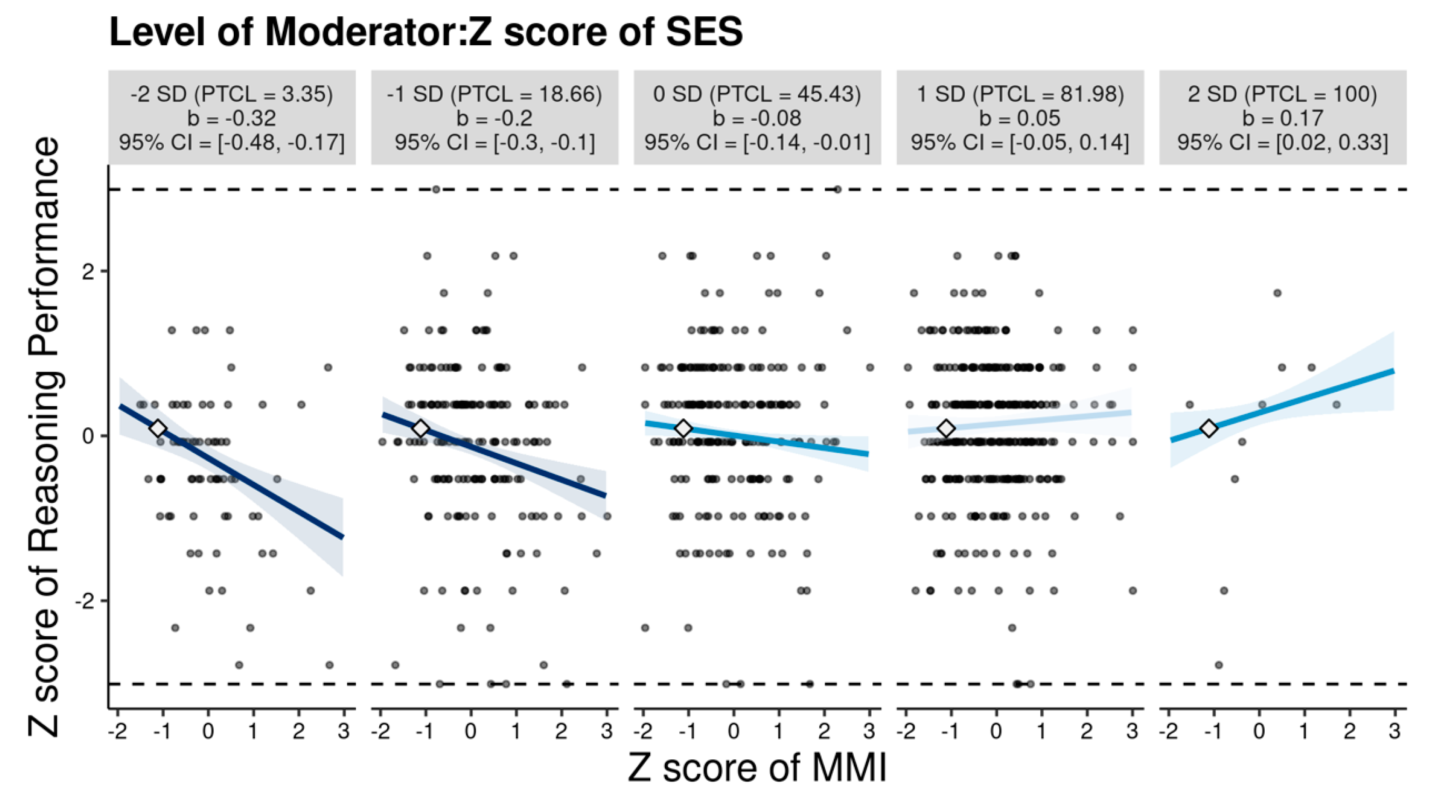
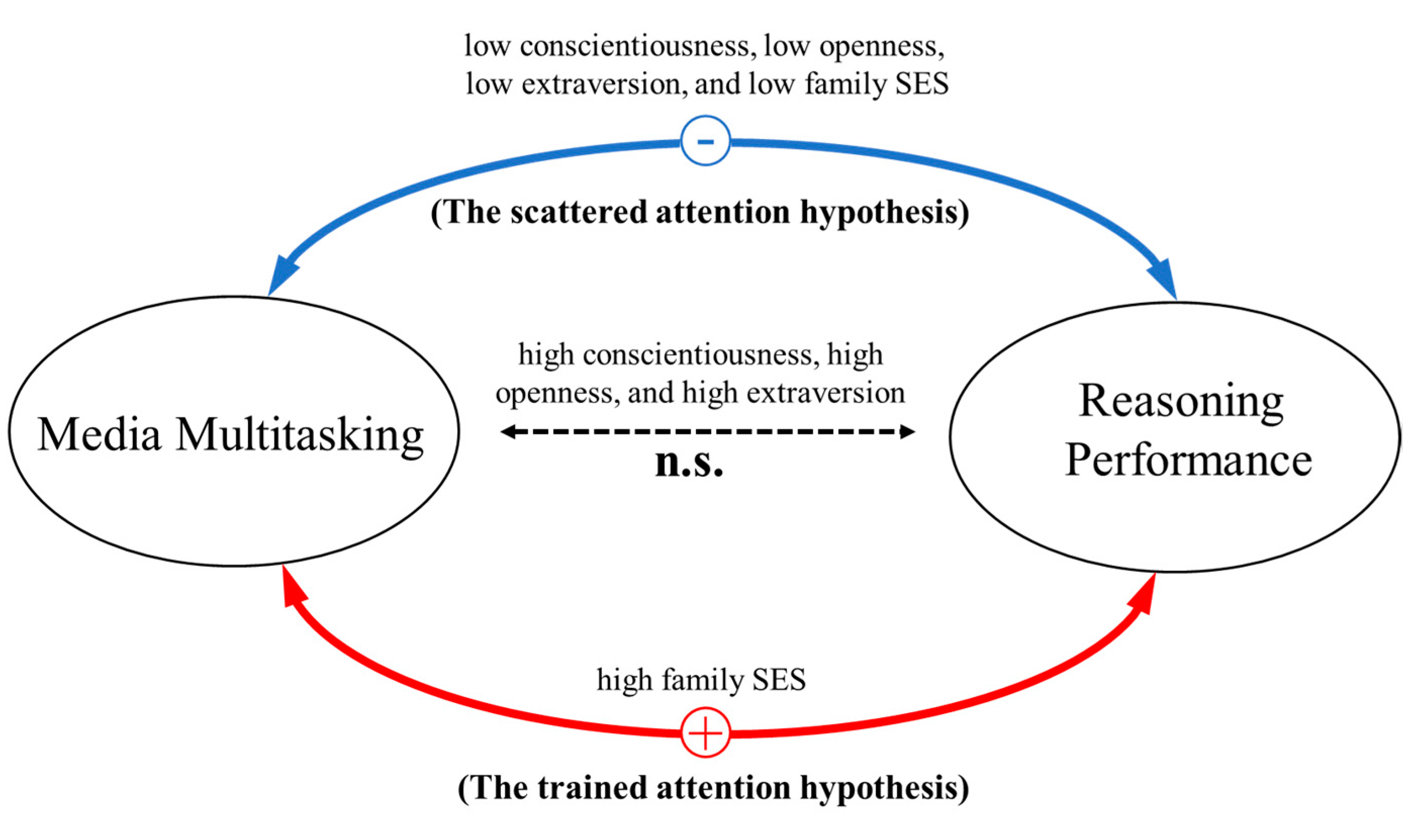
| 1 | 2 | 3 | 4 | 5 | 6 | 7 | 8 | 9 | 10 | |
|---|---|---|---|---|---|---|---|---|---|---|
| 1. MMI | - | |||||||||
| 2. APM | −0.08 * | - | ||||||||
| 3. Extraversion | 0.02 | −0.02 | - | |||||||
| 4. Agreeableness | −0.09 * | −0.05 | 0.21 *** | - | ||||||
| 5. Conscientiousness | −0.14 *** | −0.00 | 0.28 *** | 0.42 *** | - | |||||
| 6. Neuroticism | 0.18 *** | −0.07 | −0.33 *** | −0.47 *** | −0.39 *** | - | ||||
| 7. Openness | 0.00 | 0.07 * | 0.38 *** | 0.15 *** | 0.27 *** | −0.11 ** | - | |||
| 8. Impulsiveness | 0.14 *** | −0.10 ** | −0.21 *** | −0.34 *** | −0.67 *** | 0.42 *** | −0.37 *** | - | ||
| 9. Grit | −0.15 *** | 0.01 | 0.30 *** | 0.35 *** | 0.65 *** | −0.40 *** | 0.28 *** | −0.62 *** | - | |
| 10. Family SES | −0.05 | 0.16 *** | 0.17 *** | −0.00 | 0.10 ** | −0.06 | 0.25 *** | −0.20 *** | 0.14 *** | - |
| Mean | 2.17 | 11.16 | 3.01 | 3.72 | 3.43 | 2.87 | 3.59 | 2.10 | 6.48 | 0.00 |
| SD | 1.07 | 2.12 | 0.66 | 0.53 | 0.62 | 0.71 | 0.63 | 0.31 | 1.00 | 0.82 |
| Skew | 0.58 | −0.49 | 0.14 | −0.19 | −0.20 | 0.23 | −0.16 | 0.00 | 0.17 | −0.57 |
| Kurtosis | 0.19 | 0.98 | −0.45 | 0.03 | −0.23 | −0.19 | −0.16 | −0.05 | 0.02 | −0.20 |
| Reliability | − | 0.61 | 0.85 | 0.82 | 0.86 | 0.88 | 0.84 | 0.86 | 0.74 | 0.76 |
| Predictor | β | SE | t | p |
|---|---|---|---|---|
| Model 1 (F = 4.12, p = .007, R2 = 0.02) | ||||
| MMI | −0.08 | 0.04 | −2.25 | 0.025 |
| Conscientiousness | −0.01 | 0.03 | −0.30 | 0.764 |
| MMI × Conscientiousness | 0.10 | 0.04 | 2.65 | 0.008 |
| Model 2 (F = 3.98, p = .008, R2 = 0.02) | ||||
| MMI | −0.09 | 0.04 | −2.50 | 0.013 |
| Extraversion | −0.02 | 0.03 | −0.48 | 0.632 |
| MMI × Extraversion | 0.09 | 0.03 | 2.54 | 0.011 |
| Model 3 (F = 4.39, p = .004, R2 = 0.02) | ||||
| MMI | −0.09 | 0.04 | −2.39 | 0.017 |
| Openness | 0.08 | 0.03 | 2.18 | 0.030 |
| MMI × Openness | 0.07 | 0.04 | 1.99 | 0.047 |
| Model 4 (F = 3.11, p = .026, R2 = 0.01) | ||||
| MMI | −0.09 | 0.04 | −2.41 | 0.016 |
| Agreeableness | −0.06 | 0.04 | −1.61 | 0.107 |
| MMI × Agreeableness | 0.04 | 0.04 | 1.22 | 0.221 |
| Model 5 (F = 3.31, p = .020, R2 = 0.01) | ||||
| MMI | −0.07 | 0.04 | −1.99 | 0.047 |
| Neuroticism | −0.06 | 0.04 | −1.54 | 0.125 |
| MMI × Neuroticism | −0.05 | 0.03 | −1.52 | 0.129 |
| Model 6 (F = 4.31, p = .005, R2 = 0.02) | ||||
| MMI | −0.07 | 0.04 | −1.95 | 0.052 |
| Impulsiveness | −0.09 | 0.03 | −2.37 | 0.018 |
| MMI × Impulsiveness | −0.05 | 0.04 | −1.48 | 0.139 |
| Model 7 (F = 2.27, p = .079, R2 = 0.01) | ||||
| MMI | −0.08 | 0.04 | −2.15 | 0.032 |
| Grit | 0.00 | 0.04 | 0.09 | 0.929 |
| MMI × Grit | 0.05 | 0.04 | 1.28 | 0.203 |
| Model 8 (F = 11.82, p < .001, R2 = 0.04) | ||||
| MMI | −0.08 | 0.04 | −2.13 | 0.033 |
| Family SES | 0.15 | 0.04 | 4.23 | <0.001 |
| MMI × Family SES | 0.11 | 0.04 | 3.18 | 0.002 |
Disclaimer/Publisher’s Note: The statements, opinions and data contained in all publications are solely those of the individual author(s) and contributor(s) and not of MDPI and/or the editor(s). MDPI and/or the editor(s) disclaim responsibility for any injury to people or property resulting from any ideas, methods, instructions or products referred to in the content. |
© 2024 by the authors. Licensee MDPI, Basel, Switzerland. This article is an open access article distributed under the terms and conditions of the Creative Commons Attribution (CC BY) license (https://creativecommons.org/licenses/by/4.0/).
Share and Cite
Ma, Y.; Yin, J.; Xuan, H.; Ren, X.; He, J.; Wang, T. Personality Traits and Family SES Moderate the Relationship between Media Multitasking and Reasoning Performance. J. Intell. 2024, 12, 58. https://doi.org/10.3390/jintelligence12060058
Ma Y, Yin J, Xuan H, Ren X, He J, Wang T. Personality Traits and Family SES Moderate the Relationship between Media Multitasking and Reasoning Performance. Journal of Intelligence. 2024; 12(6):58. https://doi.org/10.3390/jintelligence12060058
Chicago/Turabian StyleMa, Yuning, Jinrong Yin, Hongzhou Xuan, Xuezhu Ren, Jie He, and Tengfei Wang. 2024. "Personality Traits and Family SES Moderate the Relationship between Media Multitasking and Reasoning Performance" Journal of Intelligence 12, no. 6: 58. https://doi.org/10.3390/jintelligence12060058
APA StyleMa, Y., Yin, J., Xuan, H., Ren, X., He, J., & Wang, T. (2024). Personality Traits and Family SES Moderate the Relationship between Media Multitasking and Reasoning Performance. Journal of Intelligence, 12(6), 58. https://doi.org/10.3390/jintelligence12060058






